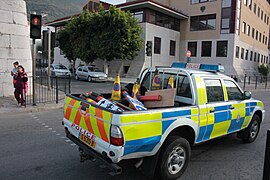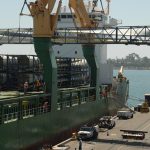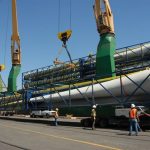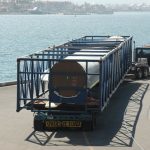Chapter 4 – Modes of Transportation
4.1 Introduction
Products need to move from one location to another location and doing that involves using a mode of transportation. Some common modes of transportation involve picking up products, using technology or using machines like trucks, boats, and airplanes to move products. Determining which of the modes of transportation to use depends on the product, urgency, and restrictions for moving that product.
A transportation restriction you may be familiar with is the Pfizer-BioNTech COVID-19 vaccine that requires the vaccine to maintain a specific frozen temperature while in transit. Requirements for transportation include keeping thermal shipping containers filled with dry ice or alternate storage should shipping take longer than the expected three-day global delivery (Pfizer Incorporated, 2022). In addition, GPS-enabled thermal sensors are required to be returned to the manufacturer (Pfizer Incorporated, 2022). As you may remember, vaccines during this worldwide pandemic were required urgently all over the world. Consider the transportation logistics that were needed to manage this situation. This chapter will look at the different ways, modes, and determinations needed when transporting products.
4.2 Learning Objectives
- Identify the different modes of transportation.
- Evaluate the characteristics, advantages and disadvantages of different transportation modes.
- Assess the infrastructure and equipment types used in different modes of transportation.
- Describe the considerations for packaging products
4.3 Pre-Assessment
4.4 Modes of Transportation
Modes of transposition are the ways, methods, vehicles and machines used to move products from one location to another location. They are demonstrated in the image below as trains, trucks, and airplanes. An emerging transportation mode is the use of drones for delivery from airports (CTV Edmonton, 2021). Common modes of transportation to move products are trucks, trains, ships and airplanes.
Figure 4.1

Note. From co-author, 2021. [Image Description]
4.5 Categories of Shipping Options
Considerations when determining which mode of transportation to use are deciding from the categories of shipping options that your product best fits. Common abbreviations and terminology that you need to know are:
- Less than a Truck Load (LTL) which is a partial truckload.
- Your product is mixed and transported with other people’s products on a truck.
- Less than a Container Load (LCL) which is a partial container load.
- Your product is mixed and transported with other people’s products in one container on a ship.
- A Full Truck Load (FTL) is a full truckload.
- Your product is the only product being transported on a truck.
- A Full Container Load (FCL) is a full shipping container load.
- Your product is the only product being shipped in one container on a ship.
- Bulk typically refers to large quantities of products and commodities, like wheat, ore, and oil.
- Bulk loads might fit into one of the FTL or LTL transportation modes.
In the context of this OER, bulk transport will refer to large quantities of products being shipped requiring ships, trains, or other modes of transport that handle such large quantities. Logistics Plus (2021) further explains the difference between these categories based on size and weight: “LTL shipments are smaller shipments typically ranging from 100 to 5,000 pounds. These smaller shipments will not fill an entire truck, leaving space for other small shipments. On the other hand, FTL shipments fill most to all of an entire truck and tend to be much larger, often weighing 20,000 pounds or more” (para. 2).
This explanatory video from Shipmate Fulfillment explains FTL, LTL and small parcel shipping:
Shipmate Fulfillment. (2020, May 12). Understanding logistics: Shipping in bulk, LTL, FTL and parcel explained [Video]. YouTube. https://youtu.be/9p0grX0kDmg
Less Than a Truck Load (LTL) and Small Packages/Parcels
FedEx, UPS, and Purolator International are well-known, large logistics companies that move many products worldwide. The focus of courier companies like this is parcels and small packages that they consolidate (put together) into trucks that move them to warehouses or distribution centres, where they are split apart then re-assembled (consolidated a second time) then sent onto their next destination. An example might be small boxes of many types and colours of pens from different small manufacturers that are collected during a delivery route and sent to a distribution centre. From there, the boxes might be opened and broken apart so that the specific order for a number of pens and specific colours can be then assembled and sent out in a smaller package to a customer. It is very much like the use of LTL space in trucks. The FedEx, UPS, and Purolator International FTL or Full Truck Load websites have excellent and current information on logistics. Visit the following websites to find a lot of information and resources about their logistics practices.
Further Reading: LTL Companies
Full Truck Load (FTL)
Full Truck Loads (FTL), are used by companies that have enough product to fill one truck. This truck would take a dedicated load from the company directly to their customer. For example, automotive manufacturing supply chains use FTL loads primarily. A dedicated container of car parts shipped from a supplier to an assembly plant is a typical FTL shipment. Automotive suppliers have more than enough products to fill one truck so FTL is a good choice for them. It is reliable and secure because the product will go directly to its destination, without making multiple stops and being unloaded. The product won’t be damaged or have some of it go missing, because it stays on the truck and is not handled again until it is unloaded at its final destination. There are various examples of FTL companies, they include Old Dominion Truck Lines and Charger Logistics Inc.
Bulk
Bulk in supply chain logistics refers to shipping products in large quantities that have not been split or packaged into smaller amounts. Some examples are raw materials required to manufacture products, agricultural commodities such as wheat, and other commodities such as Ore. Raw materials for agriculture and primary industries such as steel-making would ship in large amounts using trains, ships, and sometimes trucks to support shipping and delivery. An example of a company that can do bulk shipping is Twill, owned by Maersk.
This short video provides a definition of bulk shipping.
https://youtu.be/RdBq_NjbTOs
The Audiopedia. (2017, February 24). What is bulk cargo? What does bulk cargo mean? Bulk cargo meaning, definition & explanation [Video]. YouTube. https://youtu.be/RdBq_NjbTOs. Licensed for reuse under CC BY.
This video from Intercargo provides statistics and other information on the shipping industry, a significant form of bulk transport. Did you know that over 12,000 bulk carrier ships are sailing the seas?
Intercargo. (2020, July 29). Dry bulk shipping: Sustainably serving the world’s essential needs. https://youtu.be/vfymGkcU77I.
4.6 Information Required for Shipping
A Shipping Challenge
You have been tasked to move a product. What do you have to consider? What information do you need in order to find the best way to move your product?
Suppose you have a huge pile of wheat to move from central Saskatchewan to Australia. In that case, you will have different considerations than if you are trying to ship live lobsters from Halifax to Winnipeg, Manitoba.
The first point of clarification is the use of the word ship. You may be wondering does this mean the mode of transportation is always a large sea vessel commonly known as a ship? No, the term ship/shipping in this context is being used as a verb and means to transport which may or may not be an actual sea vessel. If you want to ship or transport something, you will need to know: The physical description of the product, the route, destination and documentation required to transport the product. You may not be able to get all of the information but the more you have, the more you can increase your chances of planning and executing the movement of your product. Information like size and weight is very important to know. Other information may not seem as important but may be needed to ensure a successful and safe shipment. Consider using the following as a template for gathering information as you plan for shipment:
Product: Physical Description and Other Pertinent Information
-
- Size
- length, width, height for the product
- length, width, the height of the packaged product
- Shape
- Weight
- as is
- when packaged
- How many
- Durability:
- has the packaging for it been specified, designed and procured?
- does it need special packaging?
- temperature requirements
- if it is fragile, how much jostling and banging can it take
- Are there any hazards involved :
- chemicals corrosive materials
- radioactivity
- biomedical/biotechnology
- limitations on how/where the product can be shipped (e.g. dangerous goods are often not allowed in tunnels)
- training required for handling and storing
- is this very new (never been shipped before so no information or history available) or is it an established product (if it has been moved before, there is information available)
- Size
Destination, Documentation and Route
- Where are you shipping from and to?
- restrictions
- trade agreements
- economic stability
- political stability
- When are you trying to ship?
- time of day, week, month, season, year
- What is the urgency of the shipment?
- is this a regular shipment or is it expedited
- What is your budget?
- has a budget or target price been set for logistics?
- if not, you may need to propose options with prices for logistics
- who is paying for the logistics? You or the receiver?
- What resources do you have available to you?
- Do you have experts in your components or do you rely on outside help or third-party companies to move your products?
- What are the documentation requirements?
- What are the insurance requirements?
Shipping Challenge Considerations
Shipping wheat from Saskatchewan to Australia
Moving a big pile of wheat from Saskatchewan to Australia would probably be done with trucks, a train to the coast, and then ship to Australia.
“Measure” for Wheat
How do you measure wheat? According to Debes (2015), “today, a bushel has a weight equivalent, different for every commodity. For wheat, one bushel equals 60 pounds of wheat or approximately one million wheat kernels. A common semi-truck grain hopper can hold approximately 1,000 bushels of wheat – or 60,000 pounds of wheat in a single load” (para. 3). A FedEx delivery van probably will not work.
Shipping Live Lobsters from Halifax, Nova Scotia to Winnipeg, Manitoba.
Shipping live lobsters from Halifax, Nova Scotia to Winnipeg, Manitoba could occur using a refrigerated truck, then air (lobster needs to be kept cold), then refrigerated truck again. Alternatively, you might use a dedicated refrigerated truck to drive directly from the lobster packing facility in Halifax to a restaurant in Winnipeg. You must take precautions to ensure that the lobsters arrive safely.
4.7 Determining the Mode of Transportation
Once you have completed a product description, parameters, restrictions, and requirements related to packaging, moving, and storing the product, you can determine the mode or method of shipment. Multimodal and intermodal use two or more transport models, but with multimodal one transport company takes responsibility for the entire journey (one contract for the entire journey). Whereas, intermodal involves one contract for each transport company involved (multiple contracts) for the various stages/modes of the journey.
It is likely that at least one of these modes includes a transport truck. Since transport trucks are a common mode of transportation, a consideration to logistics in a supply chain is the number of qualified drivers available. It is possible that the shortage of qualified transport truck drivers may impact delivery times in a supply chain. In 2013, The Conference Board of Canada identified that the demands for qualified drivers would increase due to an ageing workforce and a need to find ways to attract new drivers would be important to solve this problem (Faramarzi & Drane, n.d). It is the standard practice that the product will remain in the same container during its journey on multiple modes of transport through the supply chain. Figure 4.2 looks at five common ways of moving products and shows a comparison of the standard modes of transportation.
Diagram Summarizing Various Modes of Transportation

Note. From Faramarzi & Drane (n.d.). CC BY-NC-SA. [Image Description]
4.8 Types of Transport Trucks
There are many types of transport trucks used to move raw materials and products in a supply chain. The front of the truck is commonly referred to as a tractor or cab and couples (attaches) to different forms of trailers. The trailer is determined by the material or product that is being transported. The way in which a transport truck is referred to is often designated by the type of trailer that the tractor or cab is hauling. The following is an examination of some of the most common types of transport trucks and examples of what they transport.
Tanker Truck
Tanker trucks are used to transport fluids like oil, water, chemicals, and liquefied gasses. For example, gasoline from refineries to gas stations, edible vegetable oils to processing factories and bakeries, and raw milk to dairies. Figure 4.3 depicts a tanker truck that has a large tank as its trailer for holding and transporting liquids.
Figure 4.3
Maseru Industrial Water Tanks

Note. From Hogg, 2009. CC-BY-NC-SA
Flatbed Specialty Trailer Truck
A flatbed truck can carry many products and as demonstrated in the image below the products are not covered. Flatbed trucks may be used to carry large oversized products or products that do not require protection. Considerations when using this mode of transportation may be permits and safety precautions. For example, a permit since the load being transported is larger than most vehicles, signage saying wide load, and even a safety vehicle escort letting other drivers know that the vehicle may be dangerous to pass and is moving slowly. Figure 4.4 depicts a truck pulling a low-profile trailer that is carrying an oversized and heavy load. Due to the size of this load, special permits and escort vehicles to ensure safety are required.
Figure 4.4
Kenworth
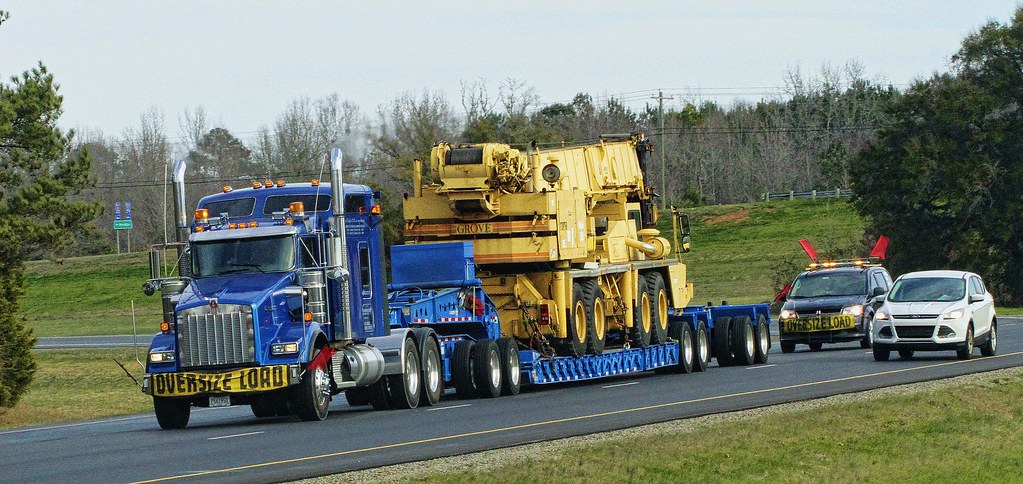
Note. From raymondclarkeimages, 2015. CC BY-NC 2.0.
Refrigerated Truck
Trucks with a refrigeration unit attached to the trailer, commonly referred to as a reefer, are used to deliver food products, medical supplies and chemicals requiring low temperatures to be safely transported. Figure 4.5 shows a refrigerated medium-sized truck used for delivering food that requires cold storage during transportation. You may remember in the introduction to this chapter we referenced the need to transport the Pfizer-BioNTech COVID-19 vaccine in cold temperatures. A refrigerated truck was required. Learn more about refrigeration requirements in this document that contains a table with the temperature requirements for the commonly used COVID-19 vaccines.
Figure 4.5
Transport Truck Trapped Under Low Bridge

Note. From Scarborough, 2007. CC BY-SA 2.0
Dump Truck
Dump trucks are rugged construction vehicles that can carry very heavy and hard-to-handle bulk material. Dump trucks are able to reach destinations such as rural areas, rough roads, and even into the backyards of people who live in the city. Dump trucks are used for carrying bulk raw materials like sand or gravel. Farmers often use dump trucks to carry bulk crops such as corn or soybeans in the supply chain as the crops are on their way to storage or processing.
This video shows a large truck dumping a load of gravel into a driveway.
Simonson, J. (2007, July 13). Gravel dump and dozer in Fairbanks, Alaska. https://youtu.be/daVXxnKE0W8. Licensed for reuse under CC BY.
Further Reading: Dumper Vehicles
What is a dumper?
“A dumper is a construction machine specifically designed to transport unconditioned materials (rubble, sand, earth). The dumper is a member of the earth-moving machine family. This equipment is usually equipped with 4 wheels with an open bucket in front of the driver. The dumper can tip and dump its load.” (Diallo, 2020, para. 1). This article discusses and shows different types of dumping vehicles.
Pick-up Trucks
Construction companies and service-orientated companies will typically use pick-up trucks to carry smaller products, packages, parts, and materials. Consumers at the end of the supply chain might use pick-up trucks to carry heavy items or to pull trailers full of products. Figure 4.7 depicts a pickup truck carrying supplies for police.
Figure 4.6
RGP Pick-Up Truck
Note. From Mitchell, 2011. CC BY 3.0
Further Reading: Pick-Up Trucks Dominate Automotive Sales Market
This CNBC article discusses how pick-up trucks dominate the United States automotive sales market: “led by trucks from the Detroit automakers, pickups accounted for five of the industry’s 10 best-selling vehicles in 2020 despite their increasingly higher prices and the coronavirus pandemic” (Wayland, 2021, para. 1).
4.9 Considerations for Transport Truck Load Sizes
Transporting by road can limit the size of loads carried due to various factors like low bridges, narrow roads, and roads not designed to carry the weight of heavy loads. If you are moving oversized products, you may need permits and plan your routes carefully. The image below from Perkins STC shows wires being lifted out of the way by utility workers to allow the truck to pass underneath safely.
Figure 4.7
Transport Truck Trapped Under Low Bridge
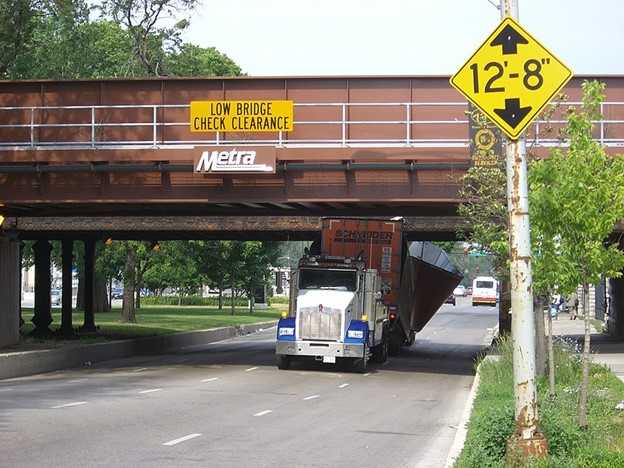 Note. From Scarborough, 2007. CC BY-SA 2.0.
Note. From Scarborough, 2007. CC BY-SA 2.0.
Further Reading: Perkins STC
Perkins STC (2017), a company that can move large objects by road, discusses the challenges of moving these products: “the toughest dimension for us to plan, permit, and execute is height. Many of our loads easily reach signs, bridges, and wires and require more time to carefully attend to details associated with a high load. It’s not just finding a route under or around low bridges, it’s about mitigating height with the proper trailer and managing the support required from utility companies, bridge engineers, and railroad vendors in order to minimize the cost and schedule impacts for our customers” (para. 1).
4.10 Bicycles
Another mode of small package delivery is bicycle courier. This mode of transportation is excellent for food, parcels, documents, or anything else requiring short and fast journeys. Figure 4.8 shows an example of a Yandex bicycle courier carrying a package in a backpack.
Figure 4.8
Yandex Courier

Note. From Stolbovsky, 2021. CC BY-SA 3.0.
4.11 Railroads
Transporting raw materials and goods by way of railroads commonly referred to as rail can be a very cost-effective way to transport long distances. Historically, it was cheaper to build railroads than it was to build roads. Canada and many parts of the world have extensive rail networks. If your factory or warehouse is located on a rail line, it is very convenient to move a lot of products via rail. Most automotive assembly factories have rail access to allow the efficient moving of their vehicles. In some cases, products have to be transported by truck to a place where the rail line can be accessed and then once at the destination, transferred from rail back to trucks for final delivery. Let’s examine some common types of ways to transport via rail:
Mixed Freight Train
Mixed freight as the name implies is a combination of different types of transport cars carrying a variety of cargo that may be raw materials and/or a variety of products. Gondola cars are typically open at the top but in the figure below the gondola cars have been covered. Figure 4.9 below, shows a freight train delivering a mix of covered gondola cars and cargo in boxcars. This type of train is very flexible and can carry a wide variety of products.
Figure 4.9
Class 50 mixed goods, July 1978
 Note. From Lewis, 1978. CC BY 2.0.
Note. From Lewis, 1978. CC BY 2.0.
Tanker Train
The demand for oil is exceeding pipeline capacity and as a result, more oil is being shipped by train even though it costs more (Walheimer, 2018). Many chemicals or liquids are moved one tanker car or a few tanker cars at a time. Trains that carry only crude oil over long distances can also be up to a kilometer long. Figure 4.10 shows a train carrying oil tanker cars.
Figure 4.10
Crude Oil Tanker
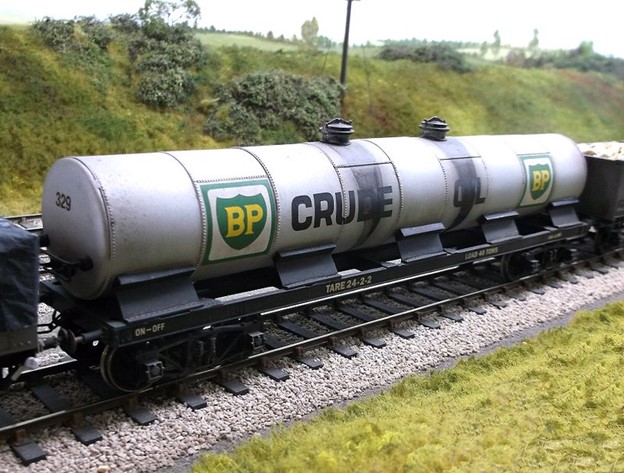 Note. From Parker, 2016. CC BY 2.0.
Note. From Parker, 2016. CC BY 2.0.
Further Reading: Shifting Logistics of Moving Oil
This article from Global News discusses how cancelling the build of an oil pipeline can shift logistics of moving oil to rail and ship: “oil will still ship but through rail. According to the federal government, as production of oil increased in Western Canada in 2018, it began to outpace pipeline capacity, meaning shipments of crude oil by rail increased to fill the gap, more than doubling from their 2017 levels.” (Dangerfield, 2021, para. 15)
Very Long Intermodal Train
Figure 4.11 shows A very long CN freight train traveling through the mountains carrying raw materials in hopper cars. This can be considered to be an intermodal delivery mode. A typical scenario would see cargo ships unload containers in a coastal port like Los Angeles, California, transfer them to a train that travels to Chicago, Illinois. In Chicago, the containers might be transferred to trucks for their final destination. The systems of these three different modes can safely and reliably be handled in the same types of shipping containers. According to Train Conductor Headquarters (2021), “a freight train length is anywhere between 140 feet [42 m] and 10,000 feet or 1.9 miles [3 km]. However, there were instances where a freight train has reached over 18,000 feet or 3.4 miles [5.4 km), pulling 295 cars” (para. 4). Read the full article.
Figure 4.11
Red and White Train on Rail Near Body of Water During Daytime
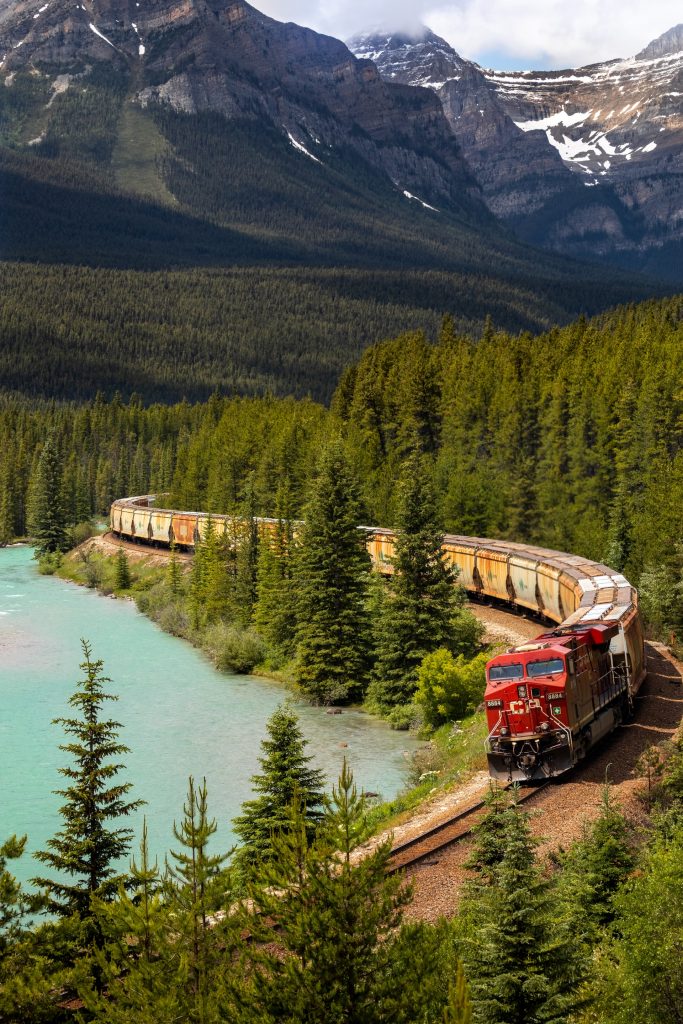 Note. From Holmes, 2020. Free to use under the Unsplash License.
Note. From Holmes, 2020. Free to use under the Unsplash License.
4.12 Airfreight/Cargo Airplanes
For goods that are expensive, small, and light, air shipping may be a good choice. Air carriers charge by a combination of the weight and size of the shipment. This mode of transport is generally used when speed is more important than cost. Shipping by air is very reliable and can be cost-effective, however, firms may want to consider the environmental impact of the regular use of air shipping. (Faramarzi & Drane, n.d., ch. 7). Cargo Airplanes are a combination of Jets and propeller aircraft that can be dedicated to fly only freight (see Figure 4.12), “Combi’s” (see Figure 4.13, 4.14) that carry both people and freight, or regular passenger airplanes that carry freight in the cargo hold underneath the aircraft. Freighter aircraft require specialized handling equipment. The facilities that support air freight are located beside or directly at airports.
Dedicated Freighter Aircraft
A dedicated freighter aircraft as its name implies is only used to transport goods/freight. There are no windows as it is not used to transport passengers.
Figure 4.12
N744CK LAX There are no windows in the main deck of this airplane because it only carries freight.
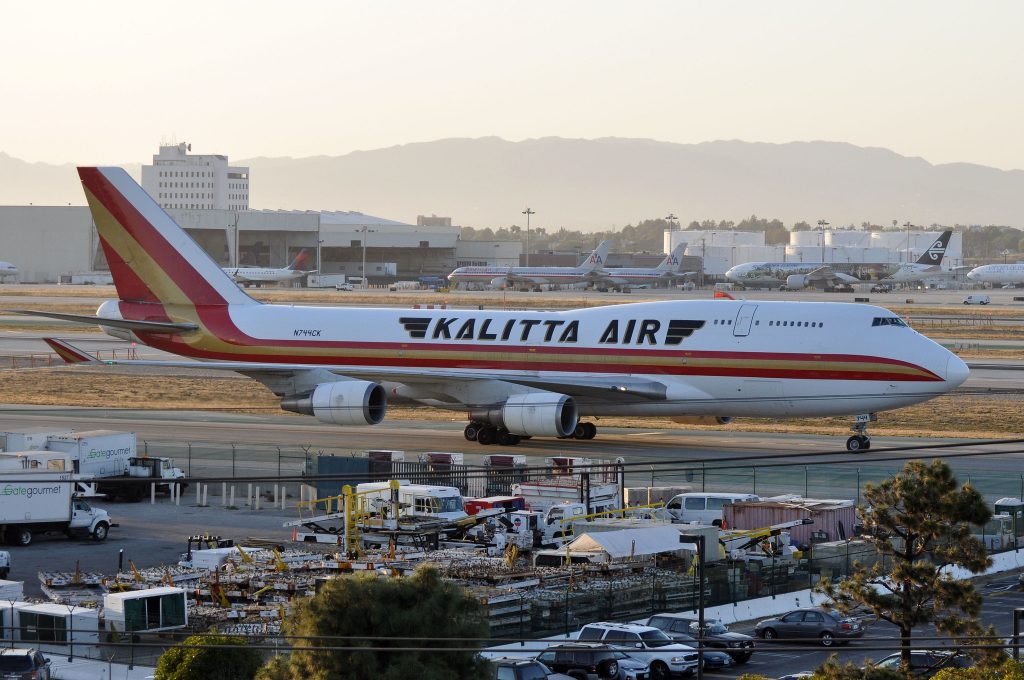 Note. From Salard, 2015. CC BY-SA 2.0.
Note. From Salard, 2015. CC BY-SA 2.0.
Further Reading: UPS Air Fleet
UPS operates a fleet of almost 600 aircraft that they own or charter. UPS and FedEx move a lot of LTL and parcel shipping via airfreight.
“Combi” Jet (Combination Freight and Passenger)
Aircraft that carry both people (in the front section) and freight (in the back section) are referred to as combination or “combi” jets. This allows flexibility for operators to get revenue from both passengers and cargo. Figure 4.14 shows an illustration of freight being loaded into the back section of a Boeing 747 combi from SAS that would carry passengers in the front section.
Figure 4.13
Boeing 747 Combi from SAS
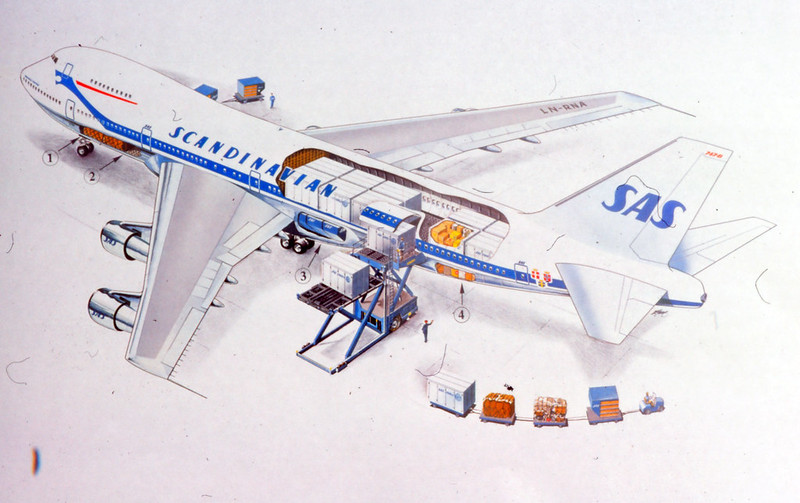 Note. From SAS Museum, Norway, 2019. CC BY-SA 2.0.
Note. From SAS Museum, Norway, 2019. CC BY-SA 2.0.
Regular Passenger Flight With Cargo in Hold Underneath the Airplane
You might be surprised by what is carried in passenger airplane cargo holds, like live lobsters and elephants (Patrick, 2017). Much freight is carried below the decks of the passenger planes, “typically between 45% and 50% of air cargo is carried in the belly holds of passenger aircraft” (Buyck, 2020, para. 5). If you are delivering small packages, the ability to harness the many destinations and frequent schedules offers high service levels and opportunities to get revenue from sources other than passengers. Figure 4.14 shows the cargo hold of a passenger plane that will be carrying freight in addition to your luggage.
Figure 4.14
Cargo Hold
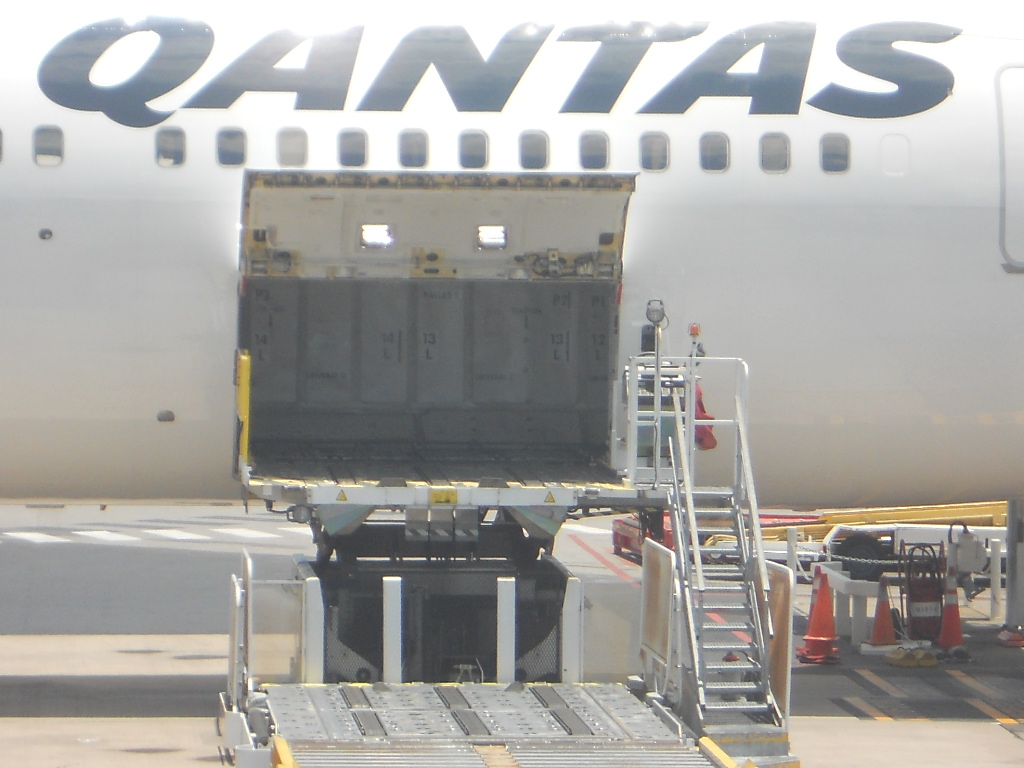 Note. From Coghlan, 2010. CC BY-SA 2.0.
Note. From Coghlan, 2010. CC BY-SA 2.0.
Pandemic Response Uses of Aircraft
Many different aircraft types were creatively used to haul supplies to help respond to the COVID-19 pandemic. Passenger aircraft were storing and moving cargo in empty seats. This was a great way to quickly move emergency supplies by adapting capacity not being used by people.
Further Reading: Passenger Cabins Used to Store Cargo
“The first option airlines turned to was simply loading up the large cargo compartments on their big passenger aircraft and flying them without passengers. Long-haul aircraft like the 777-300ER essentially have a passenger cabin on top of a small freight aircraft. The 777 carries more cargo than the 747” (Horton, 2020, para. 13).
Historical Use of Air Freight
The pandemic was not the first time that aircraft was used in creative ways to transport needed supplies. Figure 4.15 shows a Douglas DC3/C47 transport plane that was used during the Second World War to carry troops and goods.
These planes were used to transport supplies, troops, and other vehicles during World War II. They were built in America and were “the workhorse of the Allied air war. Over 10,000 were built during the campaign. The DC3’s speed, range, and carrying capacity made it perfect for the role” (National Army Museum, 1944, para. 1). The DC3 first flew in the 1930s. Over 10,00 were built. Hundreds are still flying today (Boeing, n.d., paras. 2-4).
Figure 4.15
A Jeep Being Loaded Into The Fuselage Of A Dakota Transport Plane, 1944

Note. From National Army Museum, 1944. Public domain.
4.13 Other Ways to Move Products in the Air
Drones
Are drones the future for delivering products to your door? Amazon would like to think so (Amazon, 2021). There are challenges to making drones work, including safety and managing the airspace. The cost will be a significant factor here. Are customers willing to pay a premium to get their products quickly? Check out the video below to see an example of Canada’s healthcare system using drones to deliver time-sensitive materials like organs.
CBC News: The National. (2021, October 12). Lungs for transplant delivered by drone for 1st time: health network [Video]. YouTube. https://youtu.be/BOPsrsrsSYI
Helicopters
Helicopters or rotary-wing aircraft are versatile because they can land in many different places other than an airport. They are used in the transportation and installation of air conditioner units on roofs and, as shown in Figure 4.16 below, antennae on the tops of towers, like the CN Tower in Toronto.
Figure 4.16
Evergreen Sikorsky S-64E Skycrane at Tehachapi (California) Airport
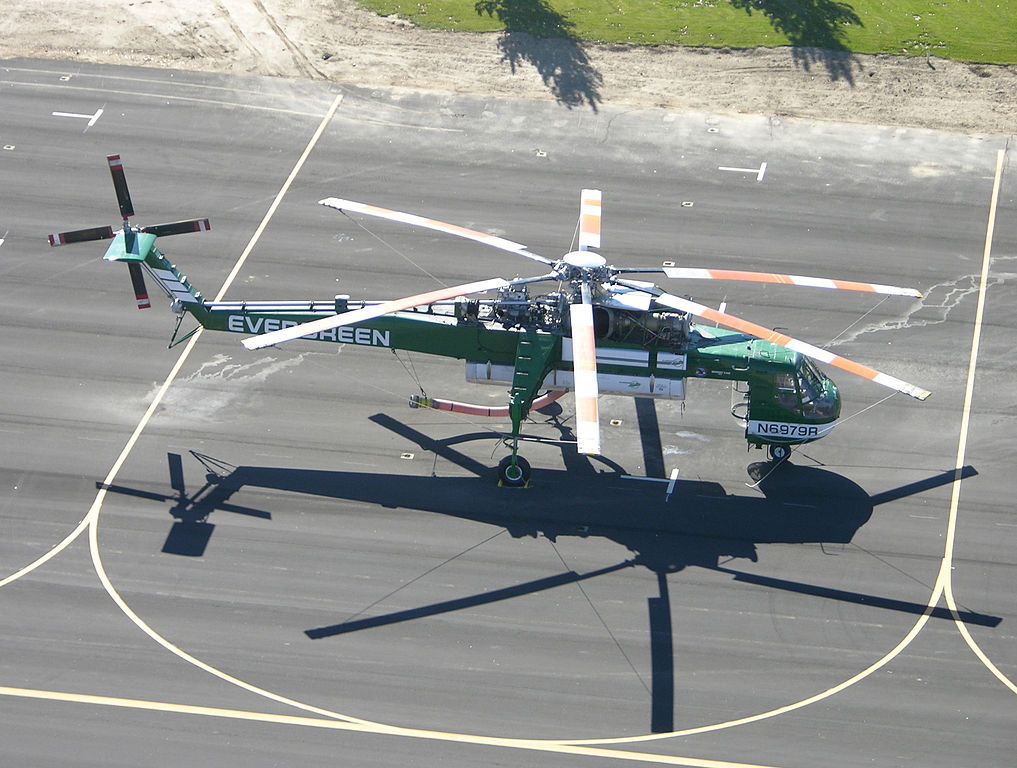 Note. From Radecki, 2006. CC BY-SA 3.0.
Note. From Radecki, 2006. CC BY-SA 3.0.
Blimps
Blimps are soft-shelled (like balloons) lighter-than-air aircraft due to the helium used in the “balloon” or bladder. Dirigibles are rigid airships that use the much lighter but much more flammable gas, hydrogen. These vehicles were used quite successfully until the 1937 Hindenburg disaster, where many people lost their lives. This ended the era of the use of dirigibles (Grossman, 2017).
Blimps can carry a limited amount of freight and people. They are used to carry cameras, conduct observation, and fly advertising banners. Due to weight restrictions, they are limited as a means of shipping freight. However, there is a resurgence in the idea to make them a productive means of transportation. The Flying Whales company and the provincial government of Quebec, Canada, have been working on a new zeppelin design that can carry freight (Morin, 2021).
Figure 4.17 shows the Good Year blimp in a field. This blimp does not have much capacity for weight but can carry a few people. Blimps are used for sightseeing, observation, and broadcasting messages.
Figure 4.17
Good Year Blimp

Note. From foundin_a_attic, 2017. CC BY 2.0.
Rockets
It might seem odd to think about rockets to move products, but innovators like Elon Musk think they will become an economical means of transport in the future. If it works, you would be able to get to most places on earth in less than an hour (Ward, 2017, para. 1). Figure 4.18 shows artist’s rendering of a BFR passenger rocket in flight.
Figure 4.18
BFR in Flight
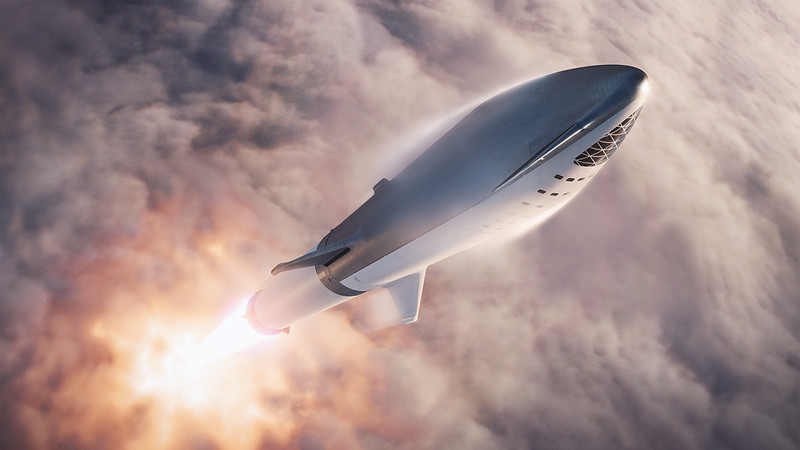 Note. From SpaceX, 2018. CC BY-NC 2.0.
Note. From SpaceX, 2018. CC BY-NC 2.0.
4.14 Water Transportation
Shipping by water is a very common way to move goods. You may remember earlier we clarified that shipping as a verb means to transport. In this section, we can look at the various types of sea vessels (ships) that are used to transport in the water. Many different products are shipped by water, but “chemicals, stone, cement, sugar, coal and other heavy commodities” (Faramarzi & Drane, n.d., ch. 7) are among the most common. Millions of containers travel by ship each year. Do you know what goods travel by ship? Read more about the commodities most commonly shipped by water.
In Canada, the St. Lawrence river that runs from the Atlantic Ocean to the Great Lakes serves as Canada’s “marine highway” (St. Lawrence Seaway Management Corporation, 2021, para .1). The St. Lawrence Seaway is a 3,700 kilometer waterway that runs between Canada and the United States. Completed in 1959 the seaway is a major trade artery that serves many industries to ship iron ore, coal, limestone, steel, grain and cement. The cost for shipping by waterways is inexpensive. Most low-cost products are shipped by waterways. (Farmarzi & Drane, n.d., ch. 7).
Container Ships
These are large ships designed to carry standardized shipping containers (see below on containers). These shipping containers usually measure 8′ x 8′ x 20′ or 8′ x 8′ x 40′ and are also used in intermodal shipping. According to Placek (2021) from Statista, “maritime shipping is the backbone of world trade; it is estimated that some 80 percent of all goods are carried by sea. In terms of value, global maritime container trade is estimated to account for around 60 percent of all seaborne trade, which was valued at around 14 trillion U.S. dollars in 2019” (para. 1).
This video from Fluctus describes how container ships work. Did you know that the largest container ships can carry over 20,000 20′ containers?
Intercargo. (2020, July 29). Dry bulk shipping: Sustainably serving the world’s essential needs [Video]. YouTube. https://youtu.be/vfymGkcU77I
Figure 4.19
Container Ship
 Note. From Ulin, 2007. CC BY-SA 2.0.
Note. From Ulin, 2007. CC BY-SA 2.0.
Bulk Carriers
These ships have large open compartments (holds) that can accommodate bulk raw materials like ore, wheat and sugar. Some have their own unloading cranes and equipment, while others depend on the port to load and unload their cargo. Figure 4.20 shows the hold of a bulk carrier. A bulldozer is being unloaded.
Figure 4.20
A Bulldozer Is Loaded On A Bulk Carrier Using A Crane, Prior To Unloading
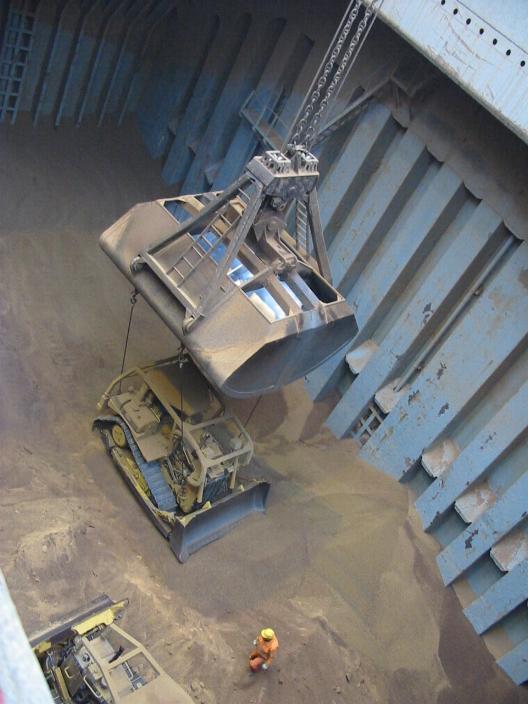 Note. From Cornelissen, 2006. CC BY.
Note. From Cornelissen, 2006. CC BY.
Tanker Ships/ Tankers
These ships are a type of bulk carrier that transports oil, gasses, and other liquids across the water.
Figure 4.21
Esso Oil Tanker

Note. From Llewelyn, 2012. CC BY-SA 2.0.
Automobile Transport Ship
Automobile transport ships are large bulky-looking ships with special docks and ramps for loading and unloading vehicles. They are known as Roll-on /Roll-off or Ro-Ro ships.
Figure 4.22
The special-purpose ship used to transport automobiles
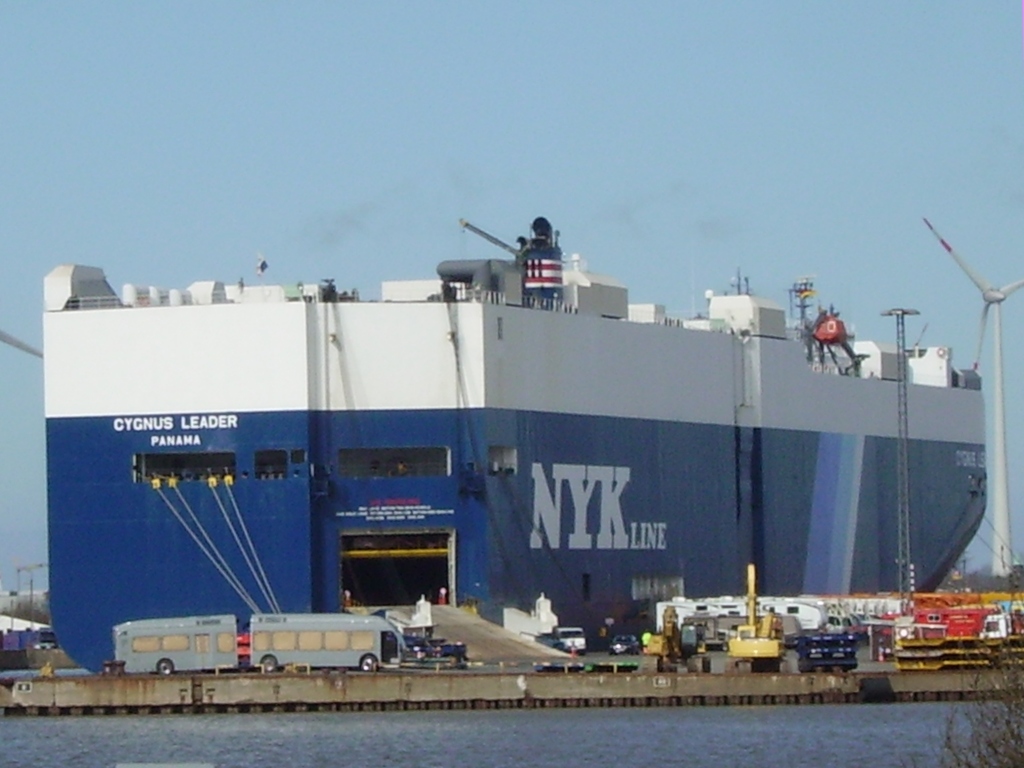 Note. From Garitzko, 2010. Public domain.
Note. From Garitzko, 2010. Public domain.
Barges
Barges are used to move on inland waterways and canals. A barge can hold as many as fifteen train box cars or sixty tractor-trailers. They also carry agricultural commodities such as cotton, grain, soybeans, wheat, corn, lumber and wood products, fertilizer, coal, construction materials, metals, sand and gravel. Barges can also transport chemicals. Gasoline, petroleum products, and other chemicals account for 200 million tons of shipping annually on the Mississippi River (Budde & Nicely, 2016, slides 23, 34).
4.15 Other Methods of Transport
Pipelines
Pipelines are the major way of shipping large volumes of products like “crude oil, natural gas and other petroleum products” (Faramarzi & Dane, n.d., ch. 7). For example, crude oil is shipped from Alberta around Canada and to much of the United States. You can see a 2020 pipeline map to see how extensive the crude oil pipeline network is.
Shipping these products via pipeline is very inexpensive once the pipelines are built. There is concern over the potential environmental impact from spills and leaks, yet others feel that pipelines are the safest way to transport oil and gas when compared to other methods, like rail (Green & Jackson, 2015). Figure 4.23 shows two workers maintaining the Trans-Canyon Pipeline. This pipeline supplies drinking water to the Grand Canyon Park.
Figure 4.23
Trans-Canyon Pipeline (Historic) 2400

Note. From Grand Canyon National Park. CC BY 2.0.
Intermodal/Multimodal Shipping
Multimodal or intermodal shipping refers to a combination of different types of transportation to move goods from origin to destination. A typical example is a combination of truck, ship, and train. The goal is to ship the goods as efficiently as possible. In multimodal shipping, the goods are shipped under a single contract with a carrier and can be easily tracked. The goods are stored in a shipping container so that they are not handled when they switch to another mode of transportation. The use of containers increases security, reduces loss and damage, and increases the speed of shipment (Faramarzi & Drane, n.d., ch. 7). Intermodal transport uses at least two modes of transportation and two contracted carriers, usually with the product remaining in the same container throughout the journey. See Figures 4.24 and 4.25 for examples.
Figure 4.24
Talleyrand Terminal Railroad
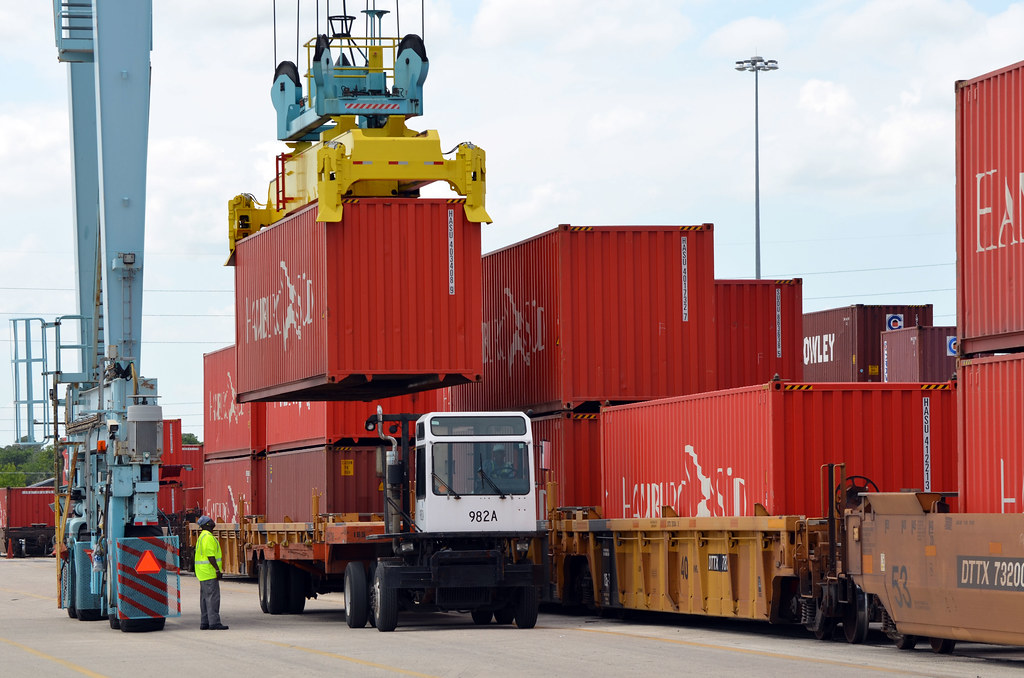
Note. From Jaxport, 2013. CC BY-NC 2.0.
Figure 4.25
Siemens Smartron 192 002 with a Freight Train
 Note. Adapted from Strîmbu, 2020. CC BY-NC-SA 2.0.
Note. Adapted from Strîmbu, 2020. CC BY-NC-SA 2.0.
One consideration to make is that each mode of transport has different restrictions, regulations, and requirements. A shipment that qualifies for rail transportation may not qualify for air transportation. Figures 4.26, 4.27 and 4.28 show windmill blades that have been unloaded from a ship onto a truck to get to their final destination.
Figures 4.26, 4.27, 4.28
Alternative Energy Cargo
Note. [Click on each image to enlarge]. Images from Port of San Diego, 2011. CC BY 2.0.
4.16 Containers, Skids, and Packaging
Shipping Containers
Containers are packed by a supplier. Standardized container sizes offer in-transit weather protection, faster load/unload times and standardized product handling. Standardization of processes means improved efficiencies and results in lower shipping costs. Containers can be carried on ships, trains or trucks and are a suitable transport method for multimodal shipments.
The standard shipping container is 40′ x 8′ x 8′. Forty-foot and twenty-foot containers are the most widely used for general shipping purposes. Other common sizes are 10-foot, and 45-foot containers.
Further Reading: Hapag-Lloyd Shipping
Hapag-Lloyd, a Germain international shipping company, provides specifications of various sizes of shipping containers.
Figure 4.29 shows a 53-foot container, for use mainly on trucks and trains, that is essentially a standard 40-foot container with extensions added to it.
Figure 4.29
53 Foot Canadian National Container

Note. From Wikideas1, 2016. Public domain.
Skids
Skids are platforms constructed of wood, plastics or other materials on which products can be placed and secured for safe movement. A standard pallet (skid with a bottom deck) “measures 48″ X 40″ with each deck board being 3 ½” wide 5/16″ thick” (C.H. Robinson Worldwide, Inc., 2021, para. 1).
Figure 4.30
Pallets
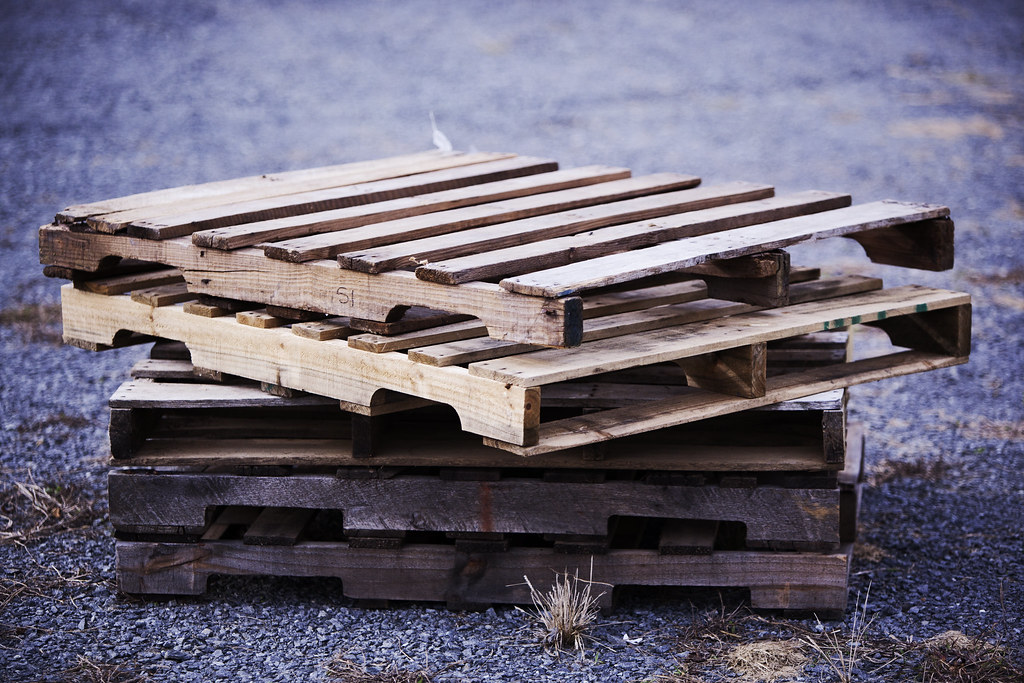
Note. From Stoneburner, 2011. CC BY 2.0.
Packaging
Packaging and protecting products for shipping is a huge subject to tackle. This section provides a very high-level overview only. Packaging protects products but is also used to help market products and ensure they are noticed. The most common purposes of packaging include the following:
- Physical protection: The product inside will require protection from the elements, mechanical vibration, compression, or other variables.
- Information transmission: Packaging often communicates instructions for use, transport, recycling, or disposal. Depending on the product, some information is mandatory and regulated by the government. Other packages include tracking and tracing information.
- Marketing: The packaging can be designed to entice the consumer to purchase the product and advertise the company or manufacturer.
- Convenience: Packaging can offer features that make disposing of, returning, handling, or storing the product easier.
- Barrier protection: Packages, depending on the product, can keep the contents fresh, sterile, clean, and safe for use or extend the product’s shelf life.
- Security: Packaging can include tamper-proof features which can help deter theft.
There are considerations to make when selecting packaging including structural design, marketing, shelf life, quality assurance, logistics, legal, regulatory, graphic design, end-use, and environmental. The design criteria, performance (specified by package testing), completion time targets, resources, and cost constraints need to be established and agreed upon.
The packaging section was adapted from The Purpose of Packaging and Packaging Considerations from Boundless Marketing by Boundless. Licensed for reuse under CC BY-SA 4.0.
These elements are related to the description of the product discussed earlier in this chapter. It is best to consider packaging requirements in the design phase to avoid surprises and increased costs when you first ship your products. Environmental concerns and what happens to both the product and its packaging should be considered to minimize negative impacts from your packaging and shipping choices.
Poor Packaging Choices
Improper packaging and handling during transportation can lead to broken and damaged products. Poor packaging can also lead to unnecessary waste and contribute to pollution, especially if the packaging materials are not recyclable.
Further Reading: Packaging to Make You Laugh (or Cry)
This GWP Group article has some excellent examples of problematic packaging practices, including wasteful, misleading, and hilarious packaging fails. Ask yourself, what could have been done better?
Figure 4.31 shows a broken shipping container and a damaged product spilling out of it. The ship itself seems to be leaning heavily indicating that there may be more damage to products in other containers.
Figure 4.31
Broken Container on a Reefer
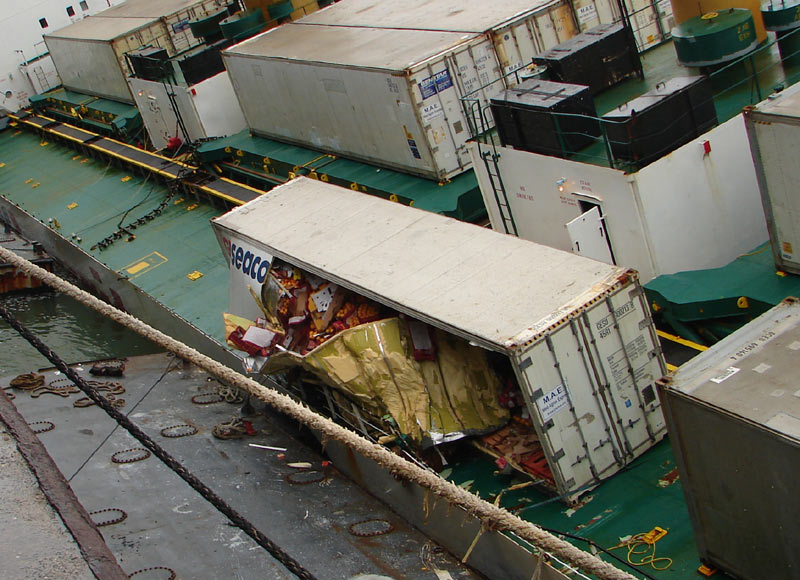
Note. From Cozanet, 2006. GNU Free Documentation License.
Food delivery also depends on appropriate packaging and safe handling. Figure 4.33 shows a damaged pizza as received when delivered from Motorino Pizza, East Village, NYC. This failure will results in extra costs and using the reverse supply chain or another delivery to fix the problem.
Figure 4.32
Motorino Pizza. East Village, NYC.
 Note. From Mikoy, 2020. CC BY 2.0.
Note. From Mikoy, 2020. CC BY 2.0.
4.17 Check Your Understanding
4.18 A Message from the Author
In 1967, the design, planning, and execution of logistics functions ensured that two people could travel to the moon. Appropriate packaging and modes of transportation were used to ensure their safe return. Your logistics decisions will not likely be as complicated as those required for the Apollo 11 mission; however, all movement of products needs to consider alternatives, impacts, and the total cost of moving and storing them.
This image shows a picture of Buzz Aldrin, taken by Neil Armstrong during the Apollo 11 mission to the moon. Incredible logistics were necessary to ensure a successful journey that returned knowledge, stories, pictures, and lunar rocks: “the two astronauts spent 21 hours on the lunar surface and returned 46 pounds [20.8 kg] of lunar rocks” (Redmond, 2008, para. 3). The logistics necessary to do this were astounding, as were the many modes of transportation used: cars, rockets, helicopters, ships, trucks, barges, trains, airplanes.
Figure 4.33
Apollo 11 Photo of Buzz Aldrin by Neil Armstrong
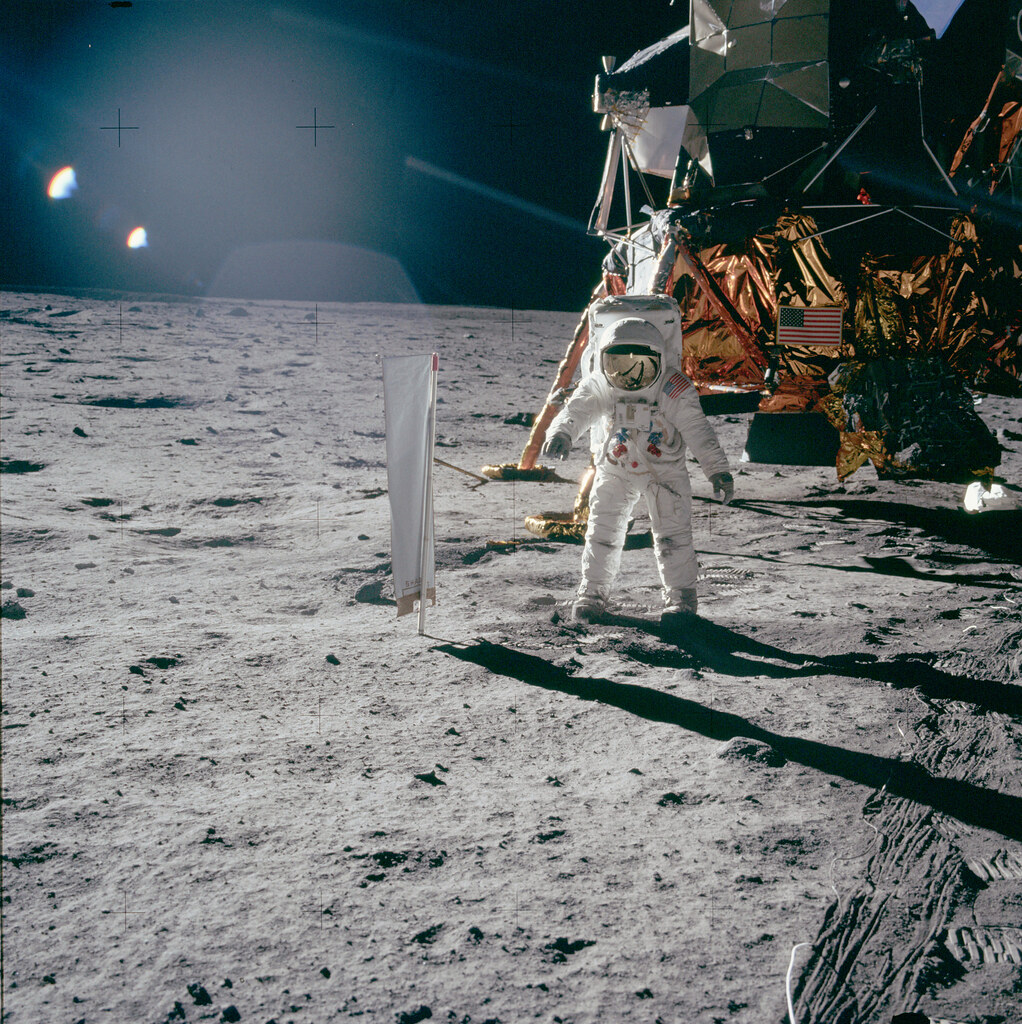
Note. From Project Apollo Archive, 2019. Public domain.
4.19 Summary
There are many modes or ways to ship products. In this chapter, we have identified and discussed common modes of transportation. Airplanes are fast but expensive and cannot carry large and heavy things. Ships are slow and limited to waterways, but their cost per unit is low, and they can carry almost anything. Transport trucks are a flexible mode used in almost every supply chain, but they depend on qualified drivers, regulations, and road rules. We have examined packaging options and the consequences of poor packaging. The specifications, cost, speed, customer requirements, and characteristics of the product help guide the logistical choice of which mode of transportation is most appropriate.
4.20 References
Boeing. (n.d.). DC-3 commercial transport. https://www.boeing.com/history/products/dc-3.page
Boundless. (n.d.). Chapter 10: Branding and packaging. Boundless Marketing. http://kolibri.teacherinabox.org.au/modules/en-boundless/www.boundless.com/marketing/textbooks/boundless-marketing-textbook/branding-and-packaging-10/index.html
Buddes, M., & Nicely, T. (2016). Exploring the economics of using barges on the mississippi river to transport agricultural commodities. National Agriculture in the Classroom. https://naitcconference.usu.edu/archive/2016/Uploads/pdfs/14601_2188MargaretBudde.pdf
Buyck, C. (2020, March 26). More airlines are stuffing cargo into passenger seats to counter Coronavirus slump. Forbes. https://www.forbes.com/sites/cathybuyck/2020/03/26/airlines-spot-revenue-opportunity-and-use-their-passenger-aircraft-to-ship-urgent-cargo/?sh=3973cdf27c68
C.H. Robinson Worldwide, Inc. (2021). Standard pallet sizes & dimensions. Freight Quote. https://www.freightquote.com/how-to-ship-freight/standard-pallet-sizes/
Coghlan, M. (2010, October 23). Cargo hold [Photographer]. Flickr. https://www.flickr.com/photos/mikecogh/5113895265/in/photolist-8MU3U2-6h1Vn1-p7VAAK-8MX97L-6xno7R. Licensed for reuse under CC BY-SA 2.0.
Cornelissen, D. (2006, March 4). A bulldozer is loaded on a bulk carrier using a crane, prior to unloading [Photograph]. Wikimedia Commons. https://commons.wikimedia.org/wiki/File:Bulldozer_loaded_on_bulk_carrier.jpg. Licensed for reuse under CC BY.
Cozanet, H. (2006, July 6). Broken container on a reefer [Photograph]. Wikimedia Commons. https://commons.wikimedia.org/wiki/File:Broken_container_on_reefer.jpg. Licensed for reuse under GNU Free Documentation License.
CTV Edmonton. (2021, July 9) Drone deliveries set to take off from Edmonton International Airport. https://edmonton.ctvnews.ca/drone-deliveries-set-to-take-off-from-edmonton-international-airport-1.5503501
Dangerfield, K. (2021, June 10). Keystone XL pipeline is officially dead. What does this mean for Canada? Global News. https://globalnews.ca/news/7937529/keystone-xl-pipeline-cancelled-alberta-canada/
Debes, J. (2015, July 22). What does a bushel mean to me? Kansas Wheat. https://kswheat.com/news/what-does-a-bushel-of-wheat-mean-to-me
Faramarzi, H., & Drane, M. (n.d.) Introduction to operations management. Seneca College Pressbooks Network. https://pressbooks.senecacollege.ca/operationsmanagementintro/. Licensed for reuse under CC BY-NC-SA.
foundin_a_attic [username]. (2017, November 22). Good year blimp [Photograph]. Flickr. https://www.flickr.com/photos/foundin_a_attic/38526357496/in/photolist-21GrDR3-21MZMY6-21Mv4Ke-21GrZmA-DE7b8h-21GUQo1-21GrJdu-21GW9fw-21MvtGn-DDE51E-21D4FLx-GQRqLM-21MvLKa-ZG9Cio-21MvnmX-21JCJcQ-2iP7m51-2iP7koG-2iP7kkL-2hMykRi-VBZxxe-2hQQkhP-2iJQynF-2kcmkRy-25443t7-21K657N-Zr1Lc6-GQRUUk-Vzzpa3-2cVgDZE-2cVgGsf. Licensed for reuse under CC BY-SA 2.0.
Garitzko. (2010, March 21). Car carrier [Photograph]. Wikimedia Commons. https://commons.wikimedia.org/wiki/Category:Cygnus_Leader_(ship,_2007)#/media/File:Car_carrier_Cygnus_Leader.jpg. Public domain.
Grand Canyon National Park. (2014, January 2). Trans-canyon pipeline (historic) 2400 [Photograph]. Flickr. https://www.flickr.com/photos/grand_canyon_nps/11720986694/in/photolist-iRK7Zu-iRH7Pz-iRJFoi-iRGEhM-eBfr9Z-eiZM8p-bhYQXV-iRGCvv-iRLNeG-iRLTtQ-iRGMya-iRHY6t-iRJm8V-iRJV8d-iRJsov-iRHWj2-iRM4Yh-j3nNdi-2k1vewD-j3q7zJ-2m1K4K5-iRLXHS-iRJfcB-iRK68J-iRH9K8-iRJCMY-iRLRPs-iRJ6Tx-iRJEi3-j3pPXA-iRGu9R-j3pWVd-j3nGNv-j3p4nT-j3nzwM-j3nLU6-j3q5XA-j3nD4X-j3pgka-j3rZ6J-j3prYz-j3ptmz-2jVLQPF-2jVMBWL-iRGCN2-iRvQ3j-iRxWtd-2jVMCuQ-iRvgMr-iRu1zB. Licensed for reuse under CC BY 2.0.
Great Lakes St. Lawrence Seaway System. (2022). The St. Lawrence Seaway: A vital waterway. https://greatlakes-seaway.com/en/the-seaway/
Green, K.P. & Jackson, T. (2015, August). Safety in the transportation of oil and gas: Pipelines or rail? Fraser Research Bulletin.
Grossman, D. (2017). The Hindenburg disaster. Airships.net. https://www.airships.net/hindenburg/disaster/
Hogg, J. (2009, June 25). Maseru industrial water tanks [Photograph]. Flickr. https://www.flickr.com/photos/worldbank/14112020821. Licensed for reuse under CC BY-NC-SA.
Holmes, A. (2020, May 11). Red and white train on rail near body of water during daytime [Photograph]. Unsplash. https://unsplash.com/photos/oEIFOoC3gi0. Free to use under the Unsplash License.
Horton, W. (2020, April 1). 7 unusual ways aircraft now fly cargo during Coronavirus outbreak. Forbes. https://www.forbes.com/sites/willhorton1/2020/04/01/7-unusual-ways-aircraft-now-fly-cargo-during-coronavirus-outbreak/?sh=682e181335b1
Jaxport. (2013, April 9). Talleyrand terminal railroad [Photograph]. Flickr. https://www.flickr.com/photos/jaxport/8634966179/in/photolist-ea3sBe-ea2TvZ-ea8yuU-ea3sVt-ea98By-ea3t4k-ea3ErH-ea98jG-ea98wm-7m7eBi-ft1dYT-ft1dUx-ft1e3M-9n4VKu-ea2Tpn-fu1fSA-5BsWqT-9n1Rtz-9n4VfJ-9n4W2j-9n1TgZ-zvdqkf-bbeug8-4VmRYB-4VmRV2-bbeupg-bbdsW8-4VmS5V-fu19rw-ishyYN-e1AYwz-ish1Tz-ishyew-ishAe3-isgYBk-ishAsj-ishS1F-ishyD9-isgYxH-ishzFQ-ishfCY-isgYcT-ishRJD-ish14i-ishfs7-diwJXR-diwJSg-diwK7k-fYfss8-eR9Hs9. Licensed for reuse under CC BY-NC 2.0.
Lewis, B. (1978, July). Class 50 mixed goods, July 1978 [Photograph]. https://commons.wikimedia.org/wiki/File:Class_50_mixed_goods,_July_1978.jpg. Licensed for reuse under CC BY 2.0.
Llewelyn, H. (2012, September 12). Esso oil tanker [Photograph]. Flickr. https://www.flickr.com/photos/camperdown/33464339572/in/photolist-SZ8ugW Licensed for reuse under CC BY-SA 2.0.
Logistics Plus. (2017, July 19). FTL versus LTL – What’s the difference? https://www.logisticsplus.com/ftl-versus-ltl-whats-the-difference/
Mikoy, C. (2020, June 14). Motorino Pizza. East Village, NYC [Photograph]. Flickr. https://www.flickr.com/photos/carlmikoy/50009042808/in/photolist-2jc8q91-6yorKu. Licensed for reuse under CC BY 2.0.
Mitchell, H. (2011, October 23). RGP pick-up truck [Photograph]. Wikimedia Commons. https://commons.wikimedia.org/wiki/File:RGP_pick-up_truck_(3).JPG. Licensed for reuse under CC BY 3.0.
Morrin, P. (2021, April 4). Giant airship project, touted as solution to remote shipping, ‘on track’ says company. CBC. https://www.cbc.ca/news/canada/north/flying-whales-schedule-1.5973192
National Army Museum. (1944). A jeep being loaded into the fuselage of a Dakota transport plane, 1944 [Photograph]. National Army Museum Online Collection. https://collection.nam.ac.uk/detail.php?acc=1974-09-79-110
Parker, P. (2016, April 16). Crude oil tanker [Photograph]. Flickr. https://www.flickr.com/photos/45131642@N00/25862940183/in/photolist-Fpqk4M-as5hWx-HujmyJ-25yuFVS-rLLDam-BuQh6X-qQ6pz8-KYYcFD-VDAYYP-LQRmBk-dq25pM-aEiGZB-tQDQt5-9wVpLU-PGgyEm-dkyhHv-9u3d97-9wVGoJ-9wKyQu-9u3dK7-cnJYuW-DgJbpw-LAHQZB-23zJSPz-9wVNws-dkgkvB-KSgpz2-9xrvuh-9tZdKv-9CeoiM-VB3zES-VB3zss-9CekVr-BtGMLR-9tE9hx-L6eJFR-9Chgpw-o86ExH-2cRw2ZN-HyWTZs-KSgn6p-9Chhxs-K3BPmR-KpfFSX-ecz3SU-JPkPJP-JZsRkR-21x21sA-KxPNh5-285qpAN. Licensed for reuse under CC BY 2.0.
Patrick, L. (2017, July 3). Curious cargo: 20 strange things you didn’t know were flying with you. Fodor’s Travel. https://www.fodors.com/news/travel-tech/curious-cargo-20-strange-things-you-didnt-know-were-flying-with-you
Perkins Specialized Transportation Contracting. (2017, February 20). What are the costly truths about moving high loads. Perkins STC. https://www.perkinsstc.com/oversize-news/2017/2/16/costly-truths-about-high-loads
Pfizer Incorporated (2022). COVID-19 vaccine U.S. distribution fact sheet. https://www.pfizer.com/news/articles/covid_19_vaccine_u_s_distribution_fact_sheet
Placek, M. (2021, September 23). Container shipping – statistics & facts. Statista. https://www.statista.com/topics/1367/container-shipping/
Port of San Diego. (2011, May 12). Alternative energy cargo [Photograph]. Flickr. https://www.flickr.com/photos/portofsandiego/with/5715895393/. Licensed for reuse under CC BY 2.0
Project Apollo Archive. (2019, July 20). Apollo 11 photo of Buzz Aldrin by Neil Armstrong [Photographer]. Flickr. https://www.flickr.com/photos/projectapolloarchive/48334391441/in/photolist-2gD9oCz-6GnwsT-6Gwkki-fpXZ5W-jkUD3P-2ikPbHC-fCYkb5-bk9aWd-bk99f1-bk9abu-6GAp8y-bk97sf-fdv21M-6GwkqB-RMXSAz-6GAp5s-dfCjgc-cYLLtb-6GAoZG-JJVmha-6H1RKr-cYMbkS-cZYRCy-fpHXBi-24JRtkr-ciabm1-6H1RHT-d753qj-azeBAg-GfPeKH-8wyRX2-dSVfXC-bWG3LJ-T8Ap1Q-6BJt9b-6BJt49-6HwwLZ-aMy9CV-wV2cKN-cAVfy3-2goHS4w-oaTR5-2gCTGN8-6H2f4k-64jJ6Q-6NhXxp-nXYBSM-8GrsNX-WRtwvR-8pkqMh. Public domain.
Radecki, A. (2006, November 11). Evergreen Sikorsky S-64E Skycrane at Tehachapi (California) Airport [Photograph]. Wikimedia Commons. https://commons.wikimedia.org/wiki/File:Evergreen-skycrane-N6979R-tehachapi-061117-02cr.jpg. Licensed for reuse under CC BY-SA 3.0.
Raymondclarkeimages. (2015, January 9). Kenworth [Photograph]. Flickr. https://www.flickr.com/photos/rclarkeimages/16086398598/in/photolist-qvuZRY-cZrjiL-qvDz7P-2kMujvY-D5VGhs-2hPKn5y-2iUKFjv-tSduTs-Wu2uoU-r3iwkC-zQRXY2-sdau1T-De5pMM-sdQPcN-coGVsy-pt8iU9-daYZco-cdmtuW-qvCfmg-cFpRnQ-pqy9nX-2hf4oS8-nuiDHg-247b3cS-qvDyHx-cYLewh-hJZBgF-fziDy7-YNP3y9-coGUZy-phsEva-y9uqcL-fbkDTq-CquLCQ-dh2a9M-eXbfUS-cvSiAJ-cd6nPQ-nd6Mf7-bEzNf9-cTemfA-nuDY51-cFpR8d-bTux5H-nwDuYt-eTDkai-cvSjf5-dVtmJv-2gCzTRb-RQnfGF. Licensed for reuse under CC BY-NC.
Redmond, C. (2008, November 12). Apollo 11: “One giant leap”. NASA. https://history.nasa.gov/apollo/apo11.html
Salard, E. (2015, April 15). N744CK LAX [Photographer]. Flickr. https://www.flickr.com/photos/airlines470/24085234315/in/photolist-CGk83B-2dRJaWj-QFE9Jd-2m8DdMi-2iR8BzH-uPdPpj-2iN8zxe-2kVBLnA-2iJeaLP-2iJgTtq-2iFcv3u-YLub7s-2iJgTzx-2kT5jHQ-2gVy6gw-2m6rvAD-2iJiwiS-FUxGpH-2iJiwfv-KBKrNi-2iJgTtf-rrNYoZ-rXGogm-jxgYZK-2iF9GU8-2jp8wGT-nwiEYe-fyjadp-qZGjyc-NQJk3j-YWcahj-rHZin6-2iUSbcN-4oqCDm-r57R7h-2m3PAPr-oxSMHg-cEgDiy-9eyC5v-2mFtQfp-prsv7a-2iPWihB-S2dBUa-2mqDeT1-r9hzEj-asysFJ-asyp5d-asvNqr-2iPTyU6-PkYXYC. Licensed for reuse under CC BY-SA 2.0.
SAS Museum Norway. (n.d.) Cargo on the half of the main deck – 1970’s. Openverse. https://wordpress.org/openverse/image/847036a7-e037-480a-a870-66b14b8595ef. licensed for reuse under CC BY-SA 2.0.
Scarborough, K. (2007, June 21). Truck crunch [Photograph]. Wikimedia Commons. https://commons.wikimedia.org/wiki/File:Truck_Crunch_(1)_(688043114).jpg. Licensed for reuse under CC BY-SA 2.0.
SpaceX. (2018, September 20). BFR in flight [Digital rendering]. Flickr. https://www.flickr.com/photos/spacex/30934146988/in/photolist-P8xAaS-P8xA3Y-P8xA7f-29SRRFx-29SRRR2-P8xAcq/. Licensed for reuse under CC BY-NC 2.0.
Stolbovsky (2021, January 2). Yandex courier [Photograph]. Wikimedia Commons. https://commons.wikimedia.org/wiki/File:Yandex.Eda_courier_01.jpg. Licensed for reuse under CC BY- SA 3.0.
Stoneburner, W. (2011, October 10). Pallets [Photograph]. Flickr. https://www.flickr.com/photos/waltstoneburner/6244758934/in/photolist-avQ2gu-jGpuRd. Licensed for reuse under CC BY 2.0.
Strîmbu, C. (2020, July 9). Siemens Smartron 192 002 with a freight train [Photograph]. Flickr. https://www.flickr.com/photos/161353030@N02/50168698871/in/photolist-2k5iPst-2j5jwxc-2ihbf3g-2jreGjK-2k7tUxR-2jjEsCL-2m7eSsm-2jmurw8-2jH7paE. Cropped. Adapted and licensed for reuse under CC BY-NC-SA 2.0.
Ulin, A. (2007, June 9) Container ship. [Photograph]. Wikimedia Commons. https://commons.wikimedia.org/wiki/File:Container_ship_Hanjin_Helsinki.jpg. Licensed for reuse under CC BY-SA 2.0.
Train Conductor Headquarters. (2021). How long is a train? Freight, passenger. Maximum allowed length? https://trainconductorhq.com/how-long-is-a-train/
Walheimer, B. (2018, August 14). Why transporting oil by rail Is popular, despite the cost. Chicago Booth Review. https://www.chicagobooth.edu/review/why-transporting-oil-rail-popular-despite-cost
Ward, P. (2017, October 3). Elon Musk wants to fly you to any city in the world in under an hour. Culture Trip. https://theculturetrip.com/north-america/usa/new-york/articles/elon-musk-wants-to-fly-you-to-any-city-in-the-world-in-under-an-hour/
Wayland, M. (2021, January 10). Pickup trucks dominate America’s 10 best-selling vehicles of 2020. CNBC. https://www.cnbc.com/2021/01/08/pickup-trucks-dominate-americas-10-best-selling-vehicles-of-2020.html
Wikideas1 [username]. (2016, December 23). 53 Foot Canadian National Container [Photograph]. Wikimedia Commons. https://commons.wikimedia.org/wiki/File:Canadian_National_53_foot_container.jpg. Public domain.
Image Descriptions
Figure 4.1: This figure shows a generic product supply chain flowchart: Raw materials selection then logistics (movement and storage, warehouses and bulk storage), then manufacture stage, then logistics (movement and storage, distribution centres and warehouses), to retail stores and/or consumers, then to product end use. [Back to Image]
Figure 4.2: This figure summarizes various modes of transportation. From left to right in the top row of the diagram, trucking is flexible, drivers in demand and creates highway congestion. In the middle, railroads are ideal for bulkier products or containers, cost-effective over distances and energy-efficient. On the right side, airfreight is ideal for small and light products, prioritizes speed over cost, reliability and air pollutants. In the bottom row from left to right, the waterway is ideal for low cost, heavy products, very common and inexpensive. In the middle of this row, there is a pipeline used for crude oil, gas, petroleum, very cost-effective once built and land and water pollutants. On the right of this row, there is multimodal, which uses a combination of modes through a carrier, products secured in containers and contractual with a single carrier. [Back to Image]

